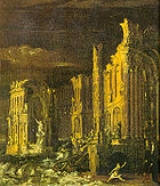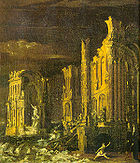
François de Nomé
Encyclopedia

France
The French Republic , The French Republic , The French Republic , (commonly known as France , is a unitary semi-presidential republic in Western Europe with several overseas territories and islands located on other continents and in the Indian, Pacific, and Atlantic oceans. Metropolitan France...
painter of the Baroque
Baroque
The Baroque is a period and the style that used exaggerated motion and clear, easily interpreted detail to produce drama, tension, exuberance, and grandeur in sculpture, painting, literature, dance, and music...
period, active mainly in Naples
Naples
Naples is a city in Southern Italy, situated on the country's west coast by the Gulf of Naples. Lying between two notable volcanic regions, Mount Vesuvius and the Phlegraean Fields, it is the capital of the region of Campania and of the province of Naples...
.
Biography
Born in MetzMetz
Metz is a city in the northeast of France located at the confluence of the Moselle and the Seille rivers.Metz is the capital of the Lorraine region and prefecture of the Moselle department. Located near the tripoint along the junction of France, Germany, and Luxembourg, Metz forms a central place...
in the Lorraine
Lorraine (région)
Lorraine is one of the 27 régions of France. The administrative region has two cities of equal importance, Metz and Nancy. Metz is considered to be the official capital since that is where the regional parliament is situated...
region, François de Nomé had moved to Rome
Rome
Rome is the capital of Italy and the country's largest and most populated city and comune, with over 2.7 million residents in . The city is located in the central-western portion of the Italian Peninsula, on the Tiber River within the Lazio region of Italy.Rome's history spans two and a half...
by 1602. He often painted under the pseudonym of Monsù Desiderio, which encompassed at least three artists, Nome and his compatriot Didier Barra, and an unknown third artist. The themes are bizarre, typically decrepit ruins or near-barren buildings in a nearly-surrealist, apparently post-apocalyptic landscape. People are tiny figures, skies overcast, tonalities earthen, and edges indistinct. His depiction of Venice's Piazza di San Marco is correctly populated by the appropriate structures, but the details are all invented.
The style was not highly influential for Italian painters of landscapes (veduta
Veduta
A veduta is a highly detailed, usually large-scale painting of a cityscape or some other vista....
) in the next century, with the exception of perhaps Alessandro Magnasco
Alessandro Magnasco
Alessandro Magnasco , also known as il Lissandrino, was an Italian late-Baroque painter active mostly in Milan and Genoa...
. However, the depictions of nightmarish wilderness amidst the detritus of civilization was a thematic adopted by painters such as Salvatore Rosa and Michelangelo Cerquozzi
Michelangelo Cerquozzi
Michelangelo Cerquozzi was an Italian Baroque painter.Born and active mainly in Rome, he is best known for small canvases of genre scenes, and for being one of the Italian proponents of the Bamboccianti style practised by a Dutch painter in Rome, Pieter van Laer...
, and reappears in the cappricci (whimsical and fantastic monuments, ruins, or buildings) of Piranesi.

